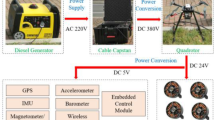Abstract
This article studies the quantitative stability of quadrotor unmanned aerial vehicles, by analyzing the dynamics model and dynamics stability at the stage of takeoff, landing and yawing, respectively. The dynamics stability problems, such as shaking, losing the tracking accuracy of command and out of control, and the design of structural parameters were investigated in detail. Dynamics stability reflects the dynamics characteristics of the whole systems, which is mainly affected by the structural parameters and control moment. The stability of system can be improved by optimizing structural parameters. The quantitative relationship between structural parameters and dynamics stability is based on the theory of Lyapunov exponent from the designing viewpoint of structural parameter, which aims at improving the reliability and stability of systems. The results indicate that the dynamics stability of systems can be promoted by optimizing the structural parameters of systems, which demonstrates the feasibility and effectiveness of this method.




















Similar content being viewed by others
References
Bai, Y.Q., Liu, H., Shi, Z.Y., et al.: Robust flight control of quadrotor unmanned air vehicles. Robot 34(5), 519–524 (2012)
Xu, Y.L.: Crash Source Investigation on the Safety of Take-Off and Landing. Xinhua, Beijing (2011)
Xiao, W.: Research on the Control Technology of Lateral Coupling for Hypersonic Vehicle. Nanjing University of Aeronautics and Astronautics, Nanjing (2014)
Kumon, M., Katupitiya, J., Mizumoto, I.: Robust attitude control of vectored thrust aeria vehicles. In: 18th IFAC World Congress, Milano, vol. 28, no. 8, pp. 2607–2613 (2011)
Dong, M.M.: Design and Dynamic Analysis of a Helicopter Landing Gear Parameters. Nanjing University of Aeronautics and Astronautics, Nanjing (2010)
Zhao, J.: The Dynamic Analysis of a Controllable Underactuated Robot. Wuhan University of Technology, Wuhan (2013)
Bosworth, J.T., West, J.C.: Real-Time Open-Loop Frequency Response Analysis of Flight Test Data. AIAA 86-9738 (1986)
Gera, J., Bosworth, J.T.: Dynamic Stability and Handling Qualities Tests on a Highly Augmented, Statically Unstable Airplane. NASA TM-88297 (1987)
Pflimlin, J.M., Soueres, P., Hamel, T.: Position control of a ducted fan VTOL UAV in crosswind. Int. J. Control 80(5), 666–683 (2007)
Li, Y.B., Song, S.X.: Hovering control for quadrotor unmanned helicopter based on fuzzy self-tuning PID algorithm. Control Eng. China 20(5), 910–914 (2013)
Sun, Y., Wu, Q.: Stability analysis via the concept of Lyapunov exponents: a case study in optimal controlled biped standing. Int. J. Control 85(12), 1952–1966 (2012)
Hong, S.T., Lee, M, Kim, D.M.: Dynamics and control of a single tit-wing UAV. In: 2012 12th International Conference on Control, Automation and Systems (ICCAS). IEEE, pp. 430–432 (2012)
Pflimlin, J.M., Soueres, P., Hamel, T.: Position control of a ducted fan VTOL UAV in crosswind. Int. J. Control 80(5), 666–683 (2007)
Islam, S., Liu, P.X., Saddik, A.: Nonlinear adaptive control for quadrotor flying vehicle. Nonlinear Dyn. 78, 117–133 (2014)
Nguyen, H.D., Vu, H.L., Volker, M.: Robust stability of differential-algebraic equations. Surv. Differ. Algebraic Eq. 2, 63–95 (2013)
Dingwell, J.B., Marin, L.C.: Kinematic variability and local dynamic stability of upper body motions when walking at different speeds. J. Biomech. 39, 444–452 (2006)
Yang, C., Wu, Q.: On stabilization of bipedal robots during disturbed standing using the concept of Lyapunov exponents. Robotica 24, 621–624 (2006)
Yang, C.X., Wu, Q.: On stability analysis via Lyapunov exponents calculated from a time series using nonlinear mapping—a case study. Nonlinear Dyn. 59, 239–257 (2010)
Yang, C.X., Wu, Q.: A robust method on estimation of Lyapunov exponents from a noisy time series. Nonlinear Dyn. 64(3), 279–292 (2011)
Sun, Y.M., Wu, C.Q.: Stability analysis via the concept of Lyapunov exponents: a case study in optimal controlled biped standing. Int. J. Control 85(12), 1952–1966 (2012)
Abdulwahab, E.N., Atiyah, Q.A., Alzahra, A.T.A.: Aircraft lateral-directional stability in critical cases via Lyapunov exponent criterion. Ai-Khwarizmi Eng. J. 1(9), 29–38 (2013)
Ershkov, S.V.: New exact solution of Euler’s equations (rigid body dynamics) in the case of rotation over the fixed point. Arch. Appl. Mech. 84, 385–389 (2014)
Liu, Y., Chen, C., Wu, H., et al.: Structural stability analysis and optimization of the quadrotor unmanned aerial vehicles via the concept of Lyapunov exponents. Int. J. Adv. Manuf. Technol. 86, 1–11 (2016)
Slaughter, S., Hales, R., Hinze, C., Pfeiffer, C.: Quantifying stability using frequency domain data from wireless inertial measurement units. Syst. Cybern. Inform. 10(4), 1–4 (2012)
Wen-Chao, Z., Si-Chao, T., Pu-Zhen, G.: Chaotic forecasting of natural circulation flow instabilities under rolling motion based on Lyapunov exponent. Acta Phys. Sin. 6(9), 605021–605028 (2013)
Ogawa, Y., Venture, G., Ott, C.: Dynamic parameters identification of a humanoid robot using joint torque sensors and/or contact forces. In: 2014 IEEE-RAS International Conference on Humanoid Robots. Madrid, pp. 457–462 (2014)
Acknowledgements
We thank the anonymous reviewers for helpful and insightful remarks. Helpful discussions with Professor Wu Qiong from Canada University of Manitoba on his guidance in Lyapunov exponent theory are gratefully acknowledged. This research is supported by the Natural Science Foundation of Jiangsu province (BK20130999), the National Natural Science Foundation of China (51405243, 51575283), Nanjing University of Information Science and Technology.
Author information
Authors and Affiliations
Corresponding author
Rights and permissions
About this article
Cite this article
Liu, Y., Li, X., Wang, T. et al. Quantitative stability of quadrotor unmanned aerial vehicles. Nonlinear Dyn 87, 1819–1833 (2017). https://doi.org/10.1007/s11071-016-3155-9
Received:
Accepted:
Published:
Issue Date:
DOI: https://doi.org/10.1007/s11071-016-3155-9




